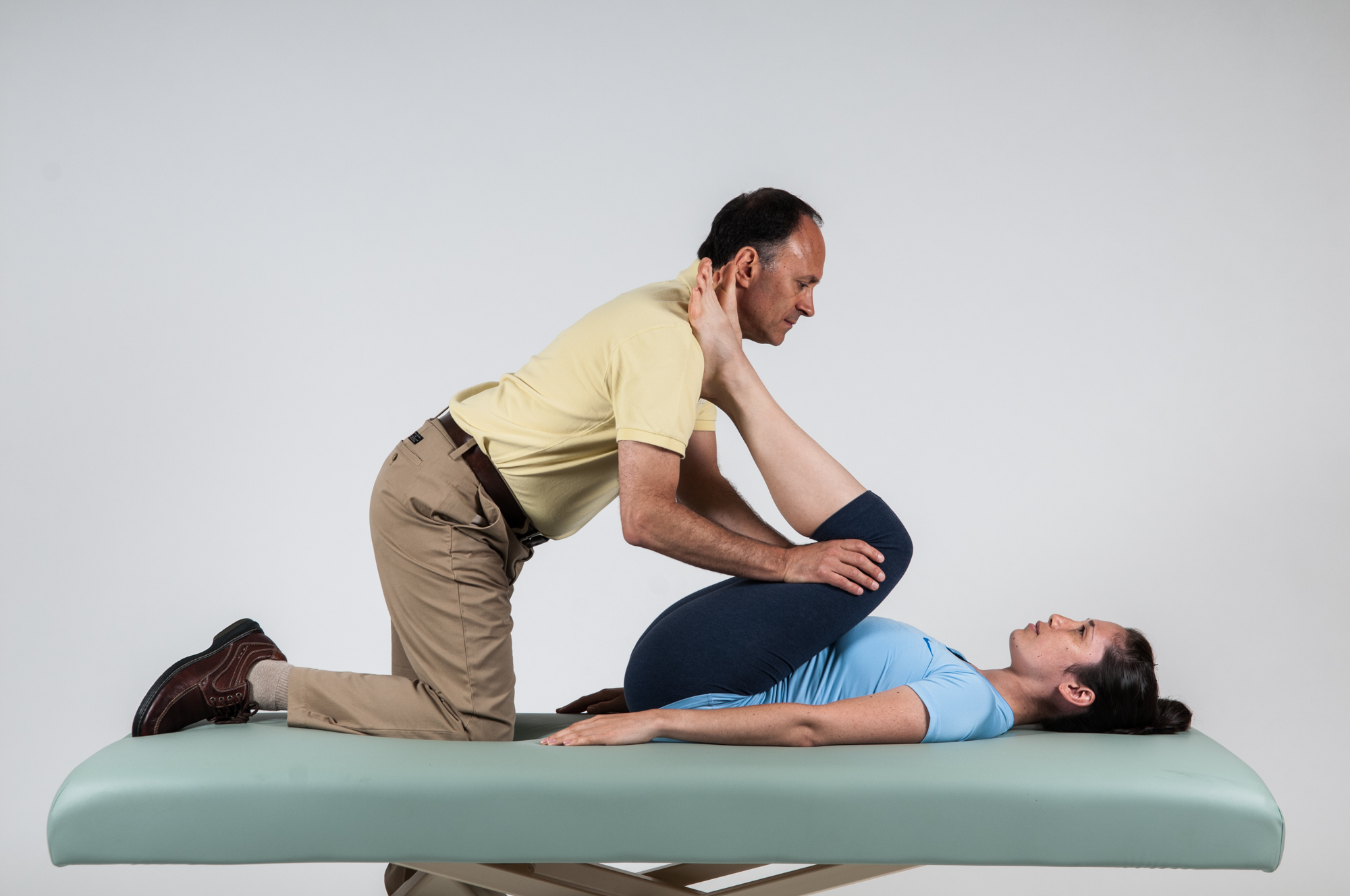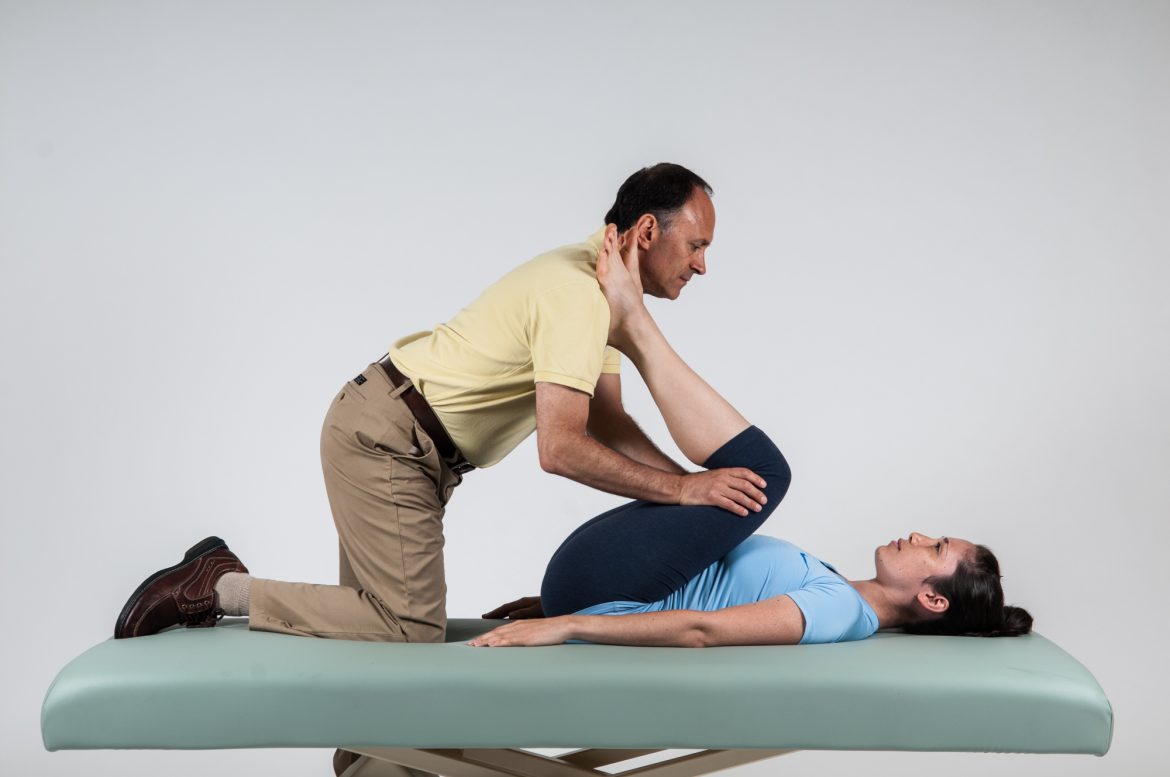Manual therapy treatment for lower crossed syndrome:

Therapist assisted double knee to chest stretch for the client with lower crossed syndrome. Permission: Joseph E. Muscolino. Manual Therapy for the Low Back and Pelvis – A Clinical Orthopedic Approach (2015).
Given that lower crossed syndrome does not cause pain in the early stages, clients/patients often do not present for treatment until this condition is very chronic and progressed, and therefore stubborn and resistant to treatment. However, if consistent care is given, lower crossed syndrome responds very well to manual therapy. Moist heat, massage, and stretching should all be done to the facilitated/tight hip flexor and adductor musculature anteriorly and the thoracolumbar extensor musculature posteriorly. Even though it is always wise to begin with light to medium pressure, transitioning to deeper pressure soft tissue manipulation is often necessary to break up long-standing fascial adhesions. At the tendons, cross-fiber work should be performed. Once direct care to the anterior hip and low back regions has been done, if time permits, it is wise to work the entirety of the thighs and trunk as well. Stretching the hamstrings is usually beneficial because they often tighten as a compensation for the inhibited gluteal musculature.
For more stubborn cases, neural inhibition stretching techniques such as contract relax (CR) (also known as PIR and PNF) and agonist contract (AC) (the basis for Aaron Mattes’ Active Isolated Stretching technique) should be used. Especially effective for the distal belly of the psoas major (distal to the inguinal ligament) and other hip flexor musculature is to use pin and stretch technique. With the client/patient supine and positioned toward the side of the table, pin the musculature with your finger pads as you bring the client’s thigh off the side of the table and down into extension. Perform a number of repetitions of this procedure, each time changing the location of the pin pressure along the hip flexor musculature. To most effectively apply this technique to the rectus femoris, make sure that the client’s knee joint is flexed; to most effectively apply this technique to the rest of the hip flexor muscles, make sure that the client’s knee joint is sufficiently extended so that the rectus femoris is not the limiting muscle during the stretch.
Because any chronic postural dysfunctional pattern will eventually result in the presence of fascial adhesions in the ligament/joint capsule complex, mobilization (arthrofascial stretching) of the hip joints, lumbar spinal, and sacroiliac joints will most likely be beneficial and should also be done.
As effective as heat, soft tissue manipulation, and stretching can be for lower crossed syndrome, the application of only these treatment modalities can never fully and permanently resolve the condition. The objective of these therapies is to loosen the tight musculature and other taut soft tissues. However, that only addresses one half of the problem. The other half of each “arm of the cross” is the inhibited weakened musculature. To truly resolve lower crossed syndrome, these muscles must be strengthened. Therefore, referral to a fitness trainer, physical therapist, yoga or Pilates instructor, or the recommendation of specific exercises to strengthen the anterior abdominal wall and posterior gluteal musculature is imperative (for more on the strengthening of these muscles, see the Self-care for the client/patient blog article on this condition).
Summary of Manual Therapy Treatment Protocol for Lower Crossed Syndrome
| 1. Heat and then soft tissue manipulation of the thoracolumbosacral region |
| 2. Heat and then soft tissue manipulation of the hip flexor and adductor musculature |
| 3. Stretching (pin and stretch) of the hip flexor musculature |
| 4. Stretching of the posterior lumbosacral region |
| 5. Stretching of the hip adductor musculature |
| 6. Mobilization (arthrofascial stretching) of the hip, lumbar spinal, and sacroiliac joints |
| 7. Work the thighs and cervicothoracic regions |
| 8. Strengthen (or refer out to strengthen) the weakened/inhibited musculature |
Precautions/contraindications:
There are a number of precautions or contraindications that should be observed when working on a client/patient with lower crossed syndrome. Regarding deep tissue massage, care should be exercised when working the anterior hip flexor region so as not to compress the femoral artery or nerve. Similarly, deep tissue massage to the proximal belly of the psoas major should be done carefully to avoid pressing too far midline onto the abdominal aorta. Regarding stretching, when stretching the hip flexors, it is extremely important to stabilize the client’s pelvis. If the client experiences low back pain during the hip flexor stretch, most likely the pelvis is not being adequately stabilized. Further, the double knee to chest stretch for the client’s thoracolumbar paraspinal musculature might be contraindicated if the client also has a pathologic lumbar disc and this stretch aggravates their disc condition.


